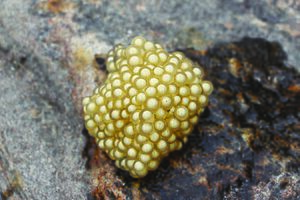Sikkim paa frog facts for kids
Quick facts for kids Sikkim paa frog |
|
|---|---|
 |
|
| Nanorana liebigii from Manaslu Conservation Area, Nepal | |
| Conservation status | |
| Scientific classification | |
| Synonyms | |
|
Megalophrys gigas Blyth, 1855 "1854"– preoccupied by Rana gigas Walbaum, 1784 |
The Nanorana liebigii, also known as the Sikkim paa frog or spiny-armed frog, is a type of frog. It belongs to the family Dicroglossidae. This frog lives in the Himalayas mountain range. You can find it in Bhutan, southern Tibet (China), northern India, and Nepal. The name liebigii was given to honor a scientist named "Dr von Liebig Jr."
What Does the Sikkim Paa Frog Look Like?
Nanorana liebigii are quite large frogs. Adult males are about 67 to 103 millimeters (2.6 to 4.1 inches) long. Females are even bigger, measuring 90 to 118 millimeters (3.5 to 4.6 inches) long. This measurement is from their snout to their bottom.
Their body is strong and thick. The frog's head is wider than it is long. Its snout, or nose area, is round. The eardrum is hard to see. Their toes have full webbing, which helps them swim. The skin on their back and sides is rough and has small bumps called warts.
Young frogs, called Tadpoles, have long tails. Their tail is twice as long as their body. A tadpole can grow to be about 82 millimeters (3.2 inches) long in total.
Where Do Sikkim Paa Frogs Live?

The Nanorana liebigii lives near streams. They are found in high mountain areas. These areas are usually covered in shrubs. They live at heights of 1,500 to 3,500 meters (about 4,900 to 11,500 feet) above sea level.
Frogs lay their eggs in streams. They often place the eggs under stones in the water. Each group of eggs, called a clutch, has about 80 to 140 white eggs. Sometimes, male frogs have been seen guarding the eggs. However, they do not always do this.
How Are Sikkim Paa Frogs Protected?
The Nanorana liebigii is common in some places where it lives. But it is rare in Tibet. These frogs face some dangers. Their homes are being lost because shrubland is cleared. Also, changes to waterways, like building dams, hurt their habitat.
In Nepal, people sometimes collect Nanorana liebigii for food. Some also believe these frogs have healing powers. This can cause fewer frogs to be in certain areas.
Luckily, these frogs live in some protected places. These include the Yadong National Nature Reserve in Tibet. They also live in the Dihang-Dibang Biosphere Reserve in India. And they are found in the Manaslu Conservation Area in Nepal. The Nanorana liebigii is a protected animal in India.



